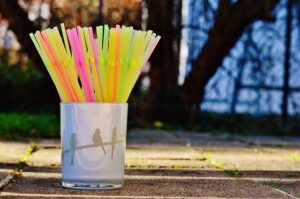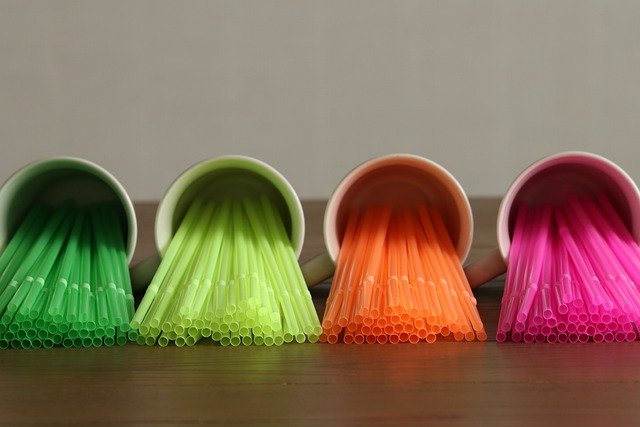Introduction – Plastic Straws
Plastic straws are widely used in the world, and they are very convenient. However, many people believe that plastic straws are one a big contributor to pollution.
They argue that plastic straws are non-biodegradable and they pollute the environment. So, are plastic straws reusable?

Are Plastic Straws Reusable?
Our Suggestion
The truth is that not enough is known about each brand of straw that we can say “all plastic straws are reusable” or “all plastic straws are not reusable”. Given the uncertainty of repeat uses between 0 and not zero, we suggest the answer is “No”, and don’t reuse plastic straws. Here’s a more nuanced consideration:
Yes
Plastic straws technically reusable if they’re washed and handled with care. They are durable enough for a few uses without showing immediate signs of wear.
No
However, they are primarily designed and manufactured for single use. There is no product guarantee for multiple uses, which means their durability isn’t assured beyond the initial use.
The structural integrity of a plastic straw may begin to degrade after just a few uses, leading to potential cracks or breaks.
Given the uncertainty around their longevity and potential health risks from degradation, it’s advisable to use them sparingly.
Always inspect them for signs of wear before each use, and if any wear is detected, it’s best to discard the straw.
Ways to Reuse Your Plastic Straws
Given that plastic straws are single use and not guaranteed to be reusable, we did not want to leave our readers in a bind with no option but to throw away the straw. As anyone who’s ever accidentally stepped on a sharp piece of plastic can attest, plastic straws are poorly biodegradable.
It’s estimated that Americans use 500 million plastic straws daily, and most of them end up in landfills or the ocean.
When you do use straws, take a look at our tips below instead of throwing them away. Here are a few creative options:
1. Turn Your Plastic Straws Into Bag Clips
If you’re looking for ways to reuse your plastic straws, one option is to turn them into bag clips. This can be a great way to keep your food fresh and avoid wasting money on disposable baggies.
To make your bag clips, simply cut the straws into pieces that are about 1-2 inches long. Then, use a hot glue gun to attach the pieces to the inside of a binder clip.
Once the glue has cooled, you can use the bag clip to seal bags of chips, pretzels, or any other snacks that you might have. You can also use it to keep track of loose papers or envelopes.
This is a great solution if you’re looking for a way to be more eco-friendly. Plus, it’s a fun project you can do with your kids.
2. Using Them As Organizational Tools
Reusable plastic straws can help to organize and sort small items. You can use them to store office supplies, such as paper clips and push pins.
They can also be used to organize and protect delicate items, such as jewelry. Reusable plastic straws can also be used to hold and transport food, such as berries and cut vegetables.
In addition, you can use them to create custom-sized storage containers for larger items, such as pens and pencils. Reusable plastic straws are an extremely versatile tool that can help to organize any space.
3. Reuse Them For Fun Arts and Crafts Projects
Did you know that you can use plastic straws for more than just sipping drinks? These days, reusable plastic straws are becoming more popular as people look for ways to reduce their reliance on single-use plastics.
And what better way to give straws a second life than by using them for fun arts and crafts projects? Here are a few arts and crafts ideas to get you started on reusing plastic straws:
1. Use straws to create unique jewelry. Cut straws into different lengths and shapes, then string them together to create colorful bracelets, necklaces, and earrings.
2. Make a miniature greenhouse. Cut the top off a 2-liter soda bottle, then insert straws around the edge of the opening. Cover the bottle with clear contact paper or cellophane to create a mini green space for your seedlings.
3. Weave a reusable shopping bag. Cut strips of fabric or old t-shirts into 1-inch wide strips, then weave the strips around plastic straws to create a sturdy reusable bag.
4. Design a one-of-a-kind mobile. Cut straws into different lengths, then thread them through colorful ribbon or yarn. Use your mobile from the ceiling or a sunny window for added flair.
5. fashioned decorative vases or plant pots. Colorful plastic straws make great upcycled vases or plant pots – just glue them together in any design you like. Let your imagination run wild!
So next time you’re finishing up your drink, don’t toss those straws in the trash – save them for your next arts and crafts project instead.

Alternatives To Using Disposable Plastic Straws
One way to help the environment is to reduce your use of disposable plastic straws. You can use several alternatives in place of disposable plastic straws. One alternative is to use reusable metal straws.
Metal straws can be washed and reused multiple times. They are also more durable than disposable plastic straws, so they will last longer. Another alternative is to use reusable glass straws.
Glass straws are made from recycled glass, so they are eco-friendly. They are also dishwasher safe and can be reused multiple times. Finally, you can ditch straws altogether and drink from a cup or a bottle. This is the best option for reducing your impact on the environment.
By making a few small changes, you can help reduce your reliance on disposable plastics and positively impact the environment.
Plastic Straw Waste Problem
There is no denying that plastic straws cause some pollution, but it is important to keep things in perspective. It is estimated that Americans use 500 million straws every day.
That’s a lot of straws, but it’s only a tiny fraction of the total plastic waste produced daily. Plastic straws make up less than 0.025% of all plastic waste worldwide.
Plastic straws can be recycled, but they are not commonly recycled because they are made of plastic, which is difficult to recycle.
Some companies are beginning to experiment with recycling programs for plastic straws. For example, McDonald’s is piloting a program to recycle used straws in the United Kingdom.
Bio-Based Polypropylene – A Way To Get Around The Carbon Emissions
One aside, now that we know straws are made of polypropylene, we know that there’s in theory a way to reduce carbon emissions.
Polypropylene (PP) is a thermoplastic polymer that is used to create a variety of everyday products, such as ropes, packaging, and automotive components.
It is known for its high strength and chemical resistance. But guess what, there’s a biomass based equivalent called Bio-PP.
Bio-PP is a form of PP that is produced from renewable sources, such as sugar cane and corn.
It has similar properties to traditional PP, but has better biodegradability and it can be used to produce compostable and biodegradable packaging materials.
The advantage of using Bio-PP is that there’s no need to extract fossil fuels in the first place. By growing biomass that accumulates carbon, turning it into Bio-PP, and then letting it decay, ensures a closed cycle.
There will still be emissions from production though.
Conclusions
We all know that plastic pollution is a big problem, and we should do our part to reduce our use of plastic. But we shouldn’t demonize straws – they’re just a small part of the problem.
Let’s focus on the real culprits of plastic pollution and ensure we’re doing our part to reduce our overall use of plastic.
